#tokyo zokei university
Photo
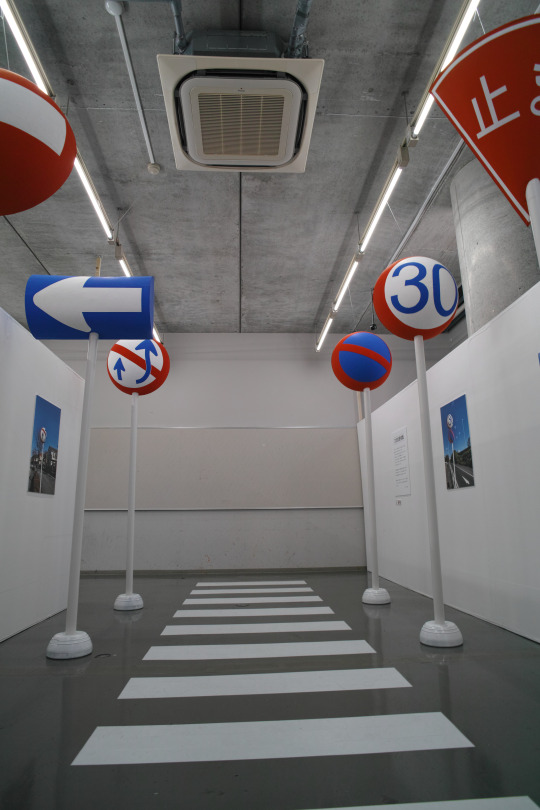
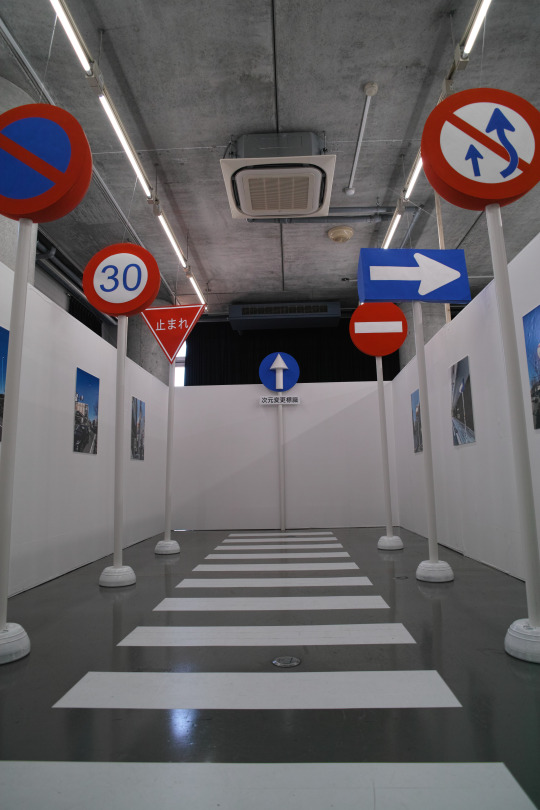
signs of dimension-change / INOUE Kota
#井上倖太#次元変更標識#東京造形大学#inoue kota#tokyo zokei university#art work#art#sign#signs#photographers on tumblr#original photographers#street photography#street photo#street photos#tokyo#20220122
167 notes
·
View notes
Text

Takato Yamamoto was born in Akita prefecture (Japan) in 1960. After graduating from the painting department of the Tokyo Zokei University, he experimented with the Ukiyo-e Pop style. He further refined and developing his “Heisei Esthetics” style. His first exhibition was held in Tokyo, in 1998.
15 notes
·
View notes
Text
Takato Yamamoto
Takato Yamamoto was born in 1960 in Akita Prefecture. A graduate in painting at Tokyo Zokei University, his art will take time to take shape.
First interested in ukyoe pop, a style that takes up the codes of ukyoe to refresh them and offer them a contemporary dimension, he will then be the initiator of his own style which he calls "Heisei aesthetics" of the name of the era of the current emperor as if to declare a new contemporary style to Japanese pictorial art.
There is a ton of violence in his works, an aesthetic sometimes gory, sometimes erotic, but rarely bordering on pornography. A little something reminiscent of Berserk at times, the violence of Griffith in the grip of demons, an immense universe, an immersion made up of small transgressive reminders, homosexuality, evil creature, death, bondage, ..., universes common to Japanese transgressive illustration but here magnified by a unique style almost an engraving.
Takato Yamamoto est né en 1960 dans la préfecture d’Akita. Diplomé de peinture à l’université de Tokyo Zokei, son art va mettre du temps à prendre forme.
Premièrement intéressé par l’ukyoe pop, un style qui reprend les codes de l’ukyoe pour les rafrâichir et leur offrir une dimension contemporaine, il va par la suite être l’initiateur de son propre style qu’il nomme « esthétisme Heisei » du nom de l’ère de l’empereur actuel comme pour déclarer un nouveau style contemporain à l’art picturale japonais.
Il y a une tonne de violence dans ses oeuvres, un esthétisme parfois gore, parfois érotique, mais rarement aux bordures de la pornographie. Un petit quelque chose rappelant Berserk par moment, la violence de Griffith en proie aux démons, un univers immense, une immersion faîte de petits rappels transgressifs, homosexualité, créature malfaisante, mort, bondage, …, des univers communs à l’illustration transgressive japonaise mais ici magnifiés par un style unique presqu’une gravure.

3 notes
·
View notes
Text

Japanese woodcut by Ray Morimura - he was born in 1948 the Japan.
Ray Morimura was born in Tokyo in 1948. He graduated from Tokyo Gakugei University. Ray Morimura began his career as a painter using abstract, geometric forms. Later he turned to woodblock printmaking. The use of geometric forms can still be found in the artist's print designs. Ray Morimura worked as an art teacher at Tokyo Zokei University and Nihon Kogakuin school.
Curator: Kristin Stobbink page of a printmaker
For more follow at Art & Printmaking
.
.
.
.
#artandall #printmakings #woodcut #raymorimura #japanesewoodcut #fineartprintmaking #reliefprintmaking #japan #Japanese #tokyo #oldmasterofprintmaking
1 note
·
View note
Text
Cultural Exchange center
with japan opening up to tourism after corona pandemic, an increase of foreign students coming to study in japanese university, as we can see with tokyo zokei university. this new school year, we have seen so many foreign students enrolling in, especially exchange students.
eventhough we live in japan, us foreign students don’t really get to experience much japanese culture, and also never have a place to share about our backgrounds too. this is a great opportunity to gather foreign students in the school and open up the univeristy to this cultural exchange center:
the programs include:
The center will be a hub for international students, offering resources and support for those who are new to the campus and the area. It will also serve as a gathering place for people from different cultures and backgrounds to come together and share their experiences. especially getting to share with
Some of the programs and activities that the center will offer include language classes, cultural workshops, international film screenings, cooking classes, and art exhibitions. It will also host cultural celebrations and festivals throughout the year, such as Chinese New Year, Diwali, and International Women's Day.
In addition to its programs and activities, the center will also serve as a resource for information about the local community and the surrounding area. It will provide guidance and support for international students who are looking for housing, employment, and other resources.
To ensure that the center is accessible to everyone, regardless of their financial situation, it will offer many of its programs and activities for free or at a low cost. It will also rely on volunteers from the university and the surrounding community to help run its programs and activities.
Overall, the Cultural Exchange Center will be a vibrant and welcoming space that promotes cross-cultural understanding and learning. It will serve as a bridge between international students and the local community, fostering connections and friendships that will last a lifetime.
0 notes
Text
Artist Research - Nobuhiro Nakanishi (Layering)
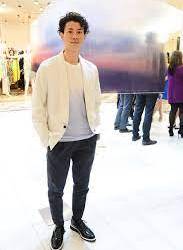
About - Nobuhiro is a Japanese artist, born in Fukuoka, Japan 1976. He studied sculpture at Tokyo Zokei University gaining Bachelor of Fine Arts, and Kyoto City of University of Art, of which he received an MA in 2002 when graduating. There is no more information on Nakanishi’s life, so I will mostly be talking about his work. He mostly works to create immersive installation experiences which attempt to capture the passage of time by using photography, sculpture and prolonged observation.
Nakanishi’s work typically involves presenting humans or objects in 3D interpretations using various media, such as wood, stone, clay and metal. He uses his art to express his thoughts around the antithetical ideas of existence and absence, the material and the non-material, the visible and the invisible, sense and conceptual territories such as consciousness, thoughts, memories and time, inviting the viewer into a mysterious and engaging experience.
Nakanishi’s installations render the abstracts and the ephemeral through serialised images on plexiglass panels, which he uses to portray the topics of absence, spatial-temporal perception and sensory experiences. Their work is typically produced as a series, by combining individual images together to produce an absract experience of the depicted subject, such as a sunset or the physical encounter with nature.
Nakanishi’s ‘Layered Drawings’ are created with photographs of environments that are taken over a long period of time and then chronologically arranged on acrylic panels to recreate temporal progressions, with small variations within each frame. This allows the art to be perceived where time has ‘no shape or boundary’, letting the experience differ from person to person. Within the gaps of the images, viewers can use their personal experience to add their perspective to the artists documentation, since each image has captured a different moment in the places history.
Nakanishi’s ‘Stripe Drawings’ depict landscapes in which distances and physical boundaries dissolve, such as a landscape covered in fog. For example; made from countless fine pencil lines produced at set intervals, the lines and spaces create shapes that appear to encroach on one another, yet coexist on the same plane - Stripe Drawing – Eclipse 3 (2013). Nakanishi implies that when the public track said lines, recreates the ‘physical experience’ of the artists free-hand drawing process, thus making the connection between the viewers and the artwork.
Nobuhiro Nakanishi has had a good amount of exhibitions, solo and group. Solo exhibitions include Gunma Museum of Art (2016); Yumiko Chiba Associates, Tokyo (2015); Kashya Hilderbrand, London (2014); Joyce Gallery, Beijing (2013); Aomori Contemporary Art Centre (2011); Gallery Nomart, Osaka (2010); and Osaka Contemporary Art Center (2006). Group exhibitions include Asia Culture Center, Gwangju (2015); Art Stage Singapore (2014); Toyota Municipal Museum of Art, Aichi (2012); The Museum of Modern Art, Wakayama (2011); 7th International Ink Painting Biennial, Shenzhen (2010); Hangaram Arts Center Museum, Seoul (2009); and Mori Art Museum, Tokyo (2007).

Quote - “We are all subject to the passing of time, yet each of us feels and perceives it in our own way,” Nakaniski says on his website. “Time itself has no shape or boundary and cannot be fixed or grasped. When we look at the photographs in these sculptures, we attempt to fill in the gaps between the individual images. We draw from our physical experiences to fill in missing time and space, both ephemeral and vague. In this series, I attempt to depict time and space as sensations shared by both viewer and artist.”
Thoughts - I’ve chosen to research Nobuhiro Nakanishi as I find his use of layer highly inspirational, I’d like to create something similar with my own work. I love the build up of colour, depth and dimension which are qualities rife within his art, creating visually intricate pieces that the viewer can dissect at each individual layer. I’d like to explore with his method of images on see through 2D material, to find how I too can create a scene that bring the viewer closer.
0 notes
Text
Nobuhiro Nakanishi
Biography
Nobuhiro Nakanishi is a Japanese artist known for his immersive installations that capture the passage of time by combining photography, sculpture, and prolonged observation.
Early Years
Born in Fukuoka, Japan, Nakanishi studied sculpture at Tokyo Zokei University and Kyoto City University of Art, where he graduated with an MA in 2002.
Nobuhiro Nakanishi Artworks
Nobuhiro Nakanishi's installations are marked by prolonged periods of observation, with nature being an ongoing subject, followed by a process in which landscapes and the passage of time are adapted to convey the indeterminacy of human perception.
Sculptural Images
Nakanishi's installations forgo traditional subjects and materials to render the abstract and the ephemeral through serialised images on plexiglass panels, commonly exploring absence, spatial-temporal perception, and sensory experience.
Often produced as series, the artist's works combine individual images together to express abstract and momentary experiences, like the sunset or the physical encounter with nature.
Layered Drawings
Amongst them, Nakanishi's 'Layered Drawings' are made by photographing environments for long periods of time and chronologically arranging the images on acrylic panels to recreate temporal progressions, with minor variations from one frame to the next.
An eerie scene, the suspended landscape in The Tactual Sky (2013) follows the trajectory of a sunrise along a mountainous horizon across 50 acrylic sheets hung from the gallery ceiling in a circle.
Likewise, Nakanishi's commission for La Prairie, Echo of Time (2020), captures peaks of the Swiss Alps at twilight to show the passage of time, while allowing for one to zoom in on individual moments.
As the artist suggests, time has 'no shape or boundary' and is experienced differently from person to person. In the gaps between Nakanishi's images, viewers are called to draw from personal experience to add their perspective to the artist's documentation.
Stripe Drawings
The 'Stripe Drawings' series seeks to depict landscapes in which contours, distances, and physical boundaries dissolve, akin to the miniature worlds one would see through a microscope, in a landscape covered in fog, or an imaginary universe.
Made from countless fine pencil lines produced at set intervals, lines and spaces create shapes that appear to encroach on one another, yet coexist on the same plane, as with Stripe Drawing – Eclipse 3 (2013).
Likewise inspired by the Swiss Alps, the installation Eternal Circle (2020) consists of 60 stripe drawings, which when aligned total at 24 metres in reference to the hours in a day. Installed in a loop, the collaboration with musician Max Richter for La Prairie hints at the eternal flow between past, present, and future.
Nakanishi suggests that looking at the lines reproduces the artist's 'physical experience' during the free-hand drawing process, thus connecting viewers and artwork.

Nakanishi composes his eye-catching installations with photographs taken over an extended period of time. Depicting unassuming environments and natural phenomena like tranquil forests and simple sunsets, the photos capture crisp snapshots of moments that would otherwise be forgotten. To evoke a sense of three-dimensionality, Nakanishi prints the photos on plexiglass acrylic and layers each sheet in chronological order. Once strategically mounted on the wall, the collection of individual photographs is transformed into a single scene that magically appears to surround its viewers and recede into the distance.
In addition to experimenting with space and altering perspectives, these stereoscopic studies take on a meditative quality. Furthermore, they present the artist's perceptions of time and his relationship with his audiences. “We are all subject to the passing of time, yet each of us feels and perceives it in our own way,” Nakaniski says on his website. “Time itself has no shape or boundary and cannot be fixed or grasped. When we look at the photographs in these sculptures, we attempt to fill in the gaps between the individual images. We draw from our physical experiences to fill in missing time and space, both ephemeral and vague. In this series, I attempt to depict time and space as sensations shared by both viewer and artist.”




0 notes
Photo


#写真展のDMを淡々とあげる
「地球派」
2022年11月21日-12月2日
TOKYO ZOKEI University CS Hal 2F Mime
出品作家:木村直、石井陽、牧野雄氣
0 notes
Text
Artist Research - Nobuhiro Nakanishi

About - Nobuhiro is a Japanese artist, born in Fukuoka, Japan 1976. He studied sculpture at Tokyo Zokei University gaining Bachelor of Fine Arts, and Kyoto City of University of Art, of which he received an MA in 2002 when graduating. There is no more information on Nakanishi’s life, so I will mostly be talking about his work. He mostly works to create immersive installation experiences which attempt to capture the passage of time by using photography, sculpture and prolonged observation.
Nakanishi’s work typically involves presenting humans or objects in 3D interpretations using various media, such as wood, stone, clay and metal. He uses his art to express his thoughts around the antithetical ideas of existence and absence, the material and the non-material, the visible and the invisible, sense and conceptual territories such as consciousness, thoughts, memories and time, inviting the viewer into a mysterious and engaging experience.
Nakanishi’s installations render the abstracts and the ephemeral through serialised images on plexiglass panels, which he uses to portray the topics of absence, spatial-temporal perception and sensory experiences. Their work is typically produced as a series, by combining individual images together to produce an absract experience of the depicted subject, such as a sunset or the physical encounter with nature.
Nakanishi’s ‘Layered Drawings’ are created with photographs of environments that are taken over a long period of time and then chronologically arranged on acrylic panels to recreate temporal progressions, with small variations within each frame. This allows the art to be perceived where time has ‘no shape or boundary’, letting the experience differ from person to person. Within the gaps of the images, viewers can use their personal experience to add their perspective to the artists documentation, since each image has captured a different moment in the places history.
Nakanishi’s ‘Stripe Drawings’ depict landscapes in which distances and physical boundaries dissolve, such as a landscape covered in fog. For example; made from countless fine pencil lines produced at set intervals, the lines and spaces create shapes that appear to encroach on one another, yet coexist on the same plane - Stripe Drawing – Eclipse 3 (2013). Nakanishi implies that when the public track said lines, recreates the ‘physical experience’ of the artists free-hand drawing process, thus making the connection between the viewers and the artwork.
Nobuhiro Nakanishi has had a good amount of exhibitions, solo and group. Solo exhibitions include Gunma Museum of Art (2016); Yumiko Chiba Associates, Tokyo (2015); Kashya Hilderbrand, London (2014); Joyce Gallery, Beijing (2013); Aomori Contemporary Art Centre (2011); Gallery Nomart, Osaka (2010); and Osaka Contemporary Art Center (2006). Group exhibitions include Asia Culture Center, Gwangju (2015); Art Stage Singapore (2014); Toyota Municipal Museum of Art, Aichi (2012); The Museum of Modern Art, Wakayama (2011); 7th International Ink Painting Biennial, Shenzhen (2010); Hangaram Arts Center Museum, Seoul (2009); and Mori Art Museum, Tokyo (2007).
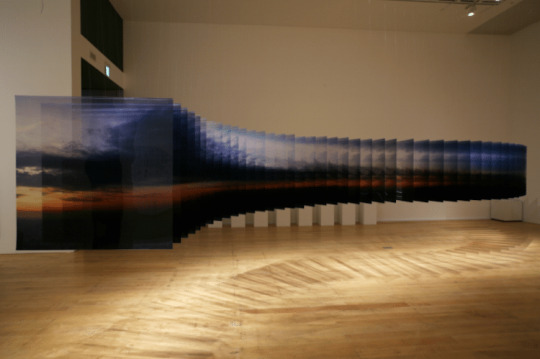
“We are all subject to the passing of time, yet each of us feels and perceives it in our own way,” Nakaniski says on his website. “Time itself has no shape or boundary and cannot be fixed or grasped. When we look at the photographs in these sculptures, we attempt to fill in the gaps between the individual images. We draw from our physical experiences to fill in missing time and space, both ephemeral and vague. In this series, I attempt to depict time and space as sensations shared by both viewer and artist.”
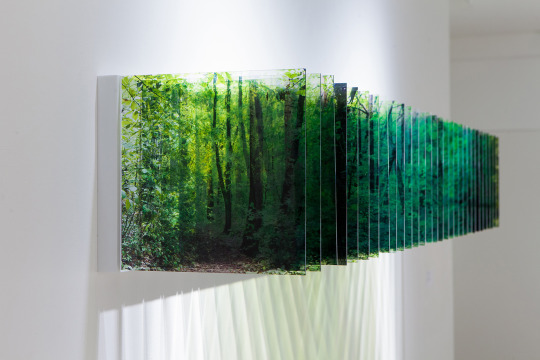
Thoughts - I’ve chosen to research Nobuhiro Nakanishi as I find his use of layer highly inspirational, I’d like to create something similar with my own work. I love the build up of colour, depth and dimension which are qualities rife within his art, creating visually intricate pieces that the viewer can dissect at each individual layer. I’d like to explore with his method of images on see through 2D material, to find how I too can create a scene that bring the viewer closer.
0 notes
Photo

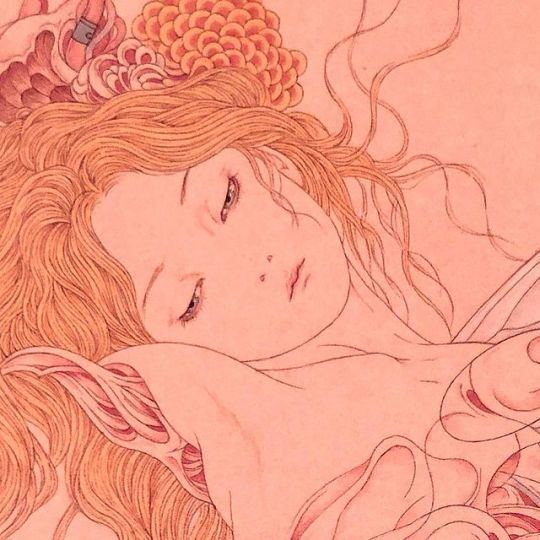



Research - Contemporary Artist - Takato Yamamoto
Takato Yamamoto was born in Akita Prefecture (Japan) in 1960. After graduating from the painting department of the Tokyo Zokei University, he experimented with the Ukiyo-e Pop style. He further refined and developed that style to create his “Heisei estheticism” style. His first exhibition was held in Tokyo, in 1998.
Resources from:
https://www.instagram.com/takatoy999/
https://www.wikiart.org/en/takato-yamamoto
6 notes
·
View notes
Photo

"Existence of Hollyhock" Karin CHINO
#葵存在#千野花鈴#tokyo zokei university#oil paint#art#art work#palace of the dragon#karin chino#hollyhock#20221015
155 notes
·
View notes
Photo
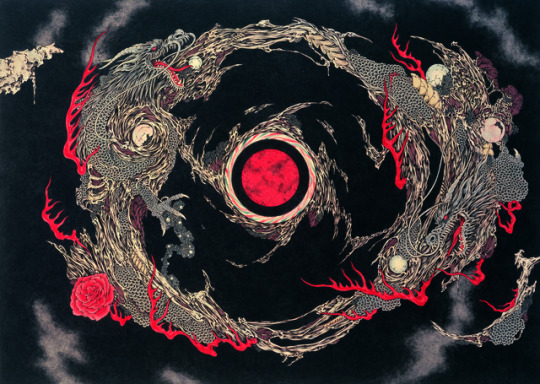


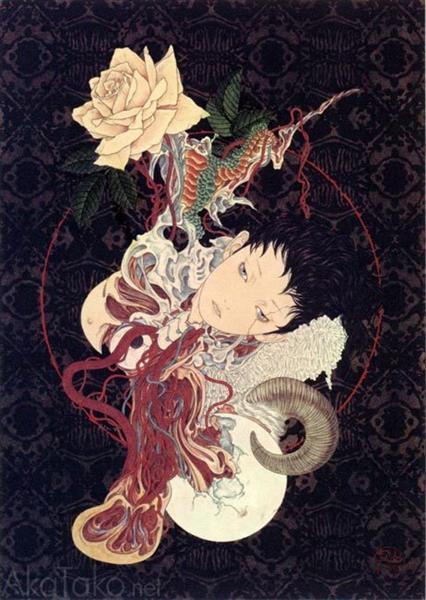


Takato Yamamoto was born in Akita Prefecture (Japan) in 1960. After graduating from the painting department of the Tokyo Zokei University, he experimented with the Ukiyo-e Pop style. He further refined and developed that style to create his “Heisei estheticism” style. His first exhibition was held in Tokyo, in 1998.
22 notes
·
View notes
Text

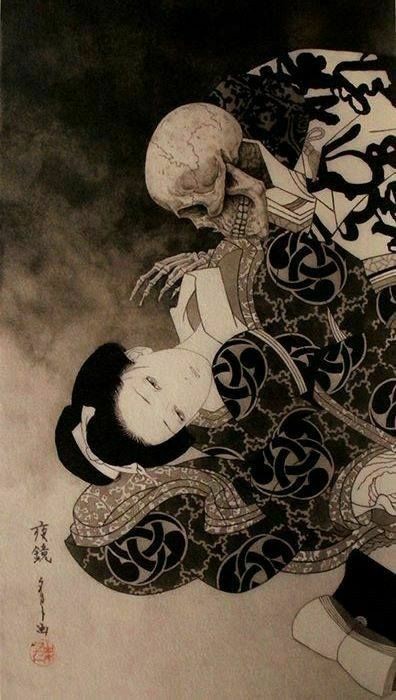


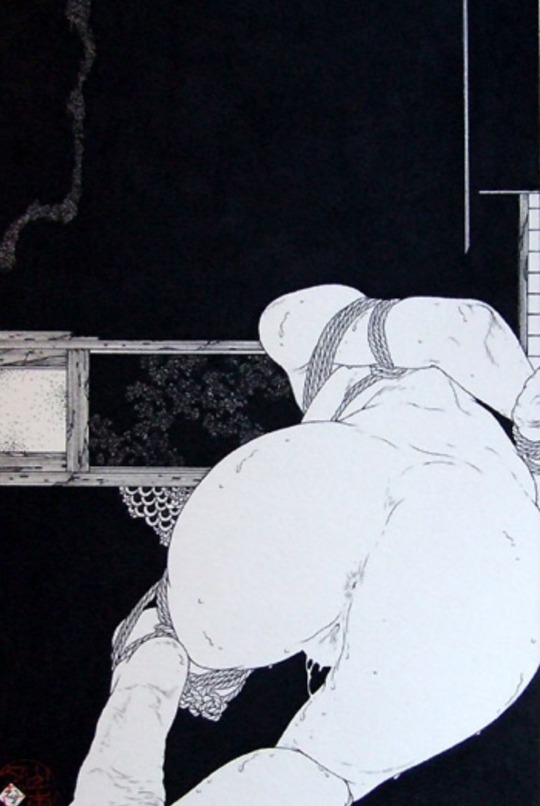
Takato Yamamoto
was born in Akita Prefecture (Japan) in 1960. After graduating from the painting department of the Tokyo Zokei University, he experimented with the Ukiyo-e Pop style. He further refined and developed that style to create his “Heisei estheticism” style. His first exhibition was held in Tokyo, in 1998.
225 notes
·
View notes
Photo



Chiba Hiro - photograph support with tree leaves - Tokyo Zokei University 東京造形大学 - Japan - 2018
- A Candle of Decalcomen
- A night of ivory
- Kikkarney Steel
Source japanization.org
#Chiba Hiro#Japanese photographer#tree leaves#vegetal photograph support#東京造形大学#Japanese art#Japan#2010s#Heisei#平成#A Candle of Decalcomen#A night of ivory#Kikkarney Steel#japanese cat#Japanese street#leaf
937 notes
·
View notes
Text

齋藤はぢめ Hajime Saito
1992年神奈川県 生まれ
2014年東京造形大学 造形学部絵画専攻 卒業
2015年美学校「アートのレシピ」 修了
東京都 在住
http://hajimesaito.jp/
■ステイトメント
社会は目紛しく動いている。その中で滞りなく生活していくためには、圧倒的な量の情報を受け止め、それらを即座に処理する力が必要とされる。社会に蔓延する先入観や既成概念といった表層的なイメージを基に、人々は無意識的に自身や物事をカテゴライズしている。その行為は揺らいでいる存在を型にはめ定める一方で、対象である自身や物事の本質をおぼろげにもさせる。 型へのインプットと、型からのアウトプットを通して内面化されていた価値や規範を再考し、そこで生まれる意識の変容を自身の体験を交えながら作品化する。
■展示歴
□個展
2016
「Non Player」ナオナカムラ
2015
「トーキョーガールズコレクション」mime 東京造形大学
□グループ展・スクリーニング
2018
「週末家族」 Weekend House
「De/en Japon」Pontifical Bolivarian University
「二人だけの国」あをば荘
2017
「第9回恵比寿映像祭」地域連携プログラム「シネマティック・プリズム」
「DE-PROGRESION」Sala de Exposiciones Carlos Drews Castro
「The Screening & Performance Shintora」SHINTORA ARTS COMPLEX
2016
「キセイノセイキ」東京都現代美術館
「東京アートウィーク2016 クロージングイベント」gallery COEXIST-TOKYO
2015
「前線」ナオナカムラ
「藤本さんち 202号室」階段部企画
「シブカル祭」渋谷PARCO
「週末家族」美学校アートのレシピ修了展
「MEC Award 2015 入選作品展」彩の国ビジュアルプラザ映像ミュージアム
「ミスターベビー・シアターvol.1 大人になれない大人のための映像芸術祭 」namGallery
2014
「齋藤真理はうそをつく」グリルギャラリー
「ZOKEI展」東京造形大学
「東京五美術大学連合卒業・修了制作展」国立新美術館
2011
「第18回日本国際パフォーマンスアートフェスティバル」神楽坂ディープラッツ 階段部
2010
「レンダリングシャンデリア」アートギャラリー道玄坂
■受賞歴
2015
「MEC Award 2015」 入選
2014
「東京造形大学 ZOKEI賞」 受賞
2012
「BEPPU ART AWARD」 パフォーマンスグループ階段部 入選
1 note
·
View note






